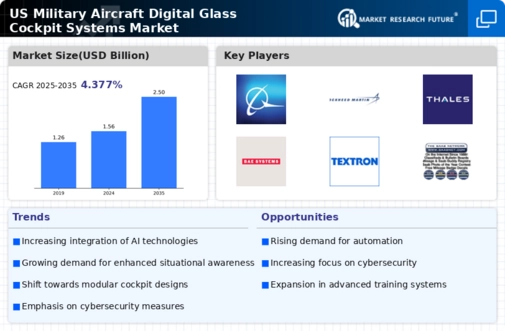The US Military Aircraft Digital Glass Cockpit Systems Market is a highly specialized sector focusing on advanced avionics solutions designed to enhance pilot situational awareness, improve operational efficiency, and bolster aircraft safety. The market is characterized by a competitive landscape featuring key players that invest heavily in research and development to innovate and deliver highly integrated cockpit systems. These systems often incorporate cutting-edge technologies such as electronic flight displays, enhanced flight vision systems, and multi-functional displays, which help streamline mission operations in complex environments.
The increasing demand for modernized military aircraft, driven by advancing warfare tactics and the need for interoperability among allied forces, is propelling the growth of this market. Additionally, defense budgets and government contracts also significantly influence the competitive dynamics and development timelines within this rapidly evolving sector.Raytheon Technologies holds a significant position in the US Military Aircraft Digital Glass Cockpit Systems Market by leveraging its strong technological expertise and innovative capabilities. The company is known for developing state-of-the-art avionics that are seamlessly integrated with various military platforms, offering advanced solutions tailored to the unique needs of military operations.
Raytheon Technologies benefits from a robust supply chain and strategic partnerships with the Department of Defense, promoting a favorable reputation in defense contracting. The company consistently prioritizes research and development, aiming to enhance the effectiveness and reliability of its cockpit systems. Its commitment to delivering cutting-edge technology ensures that Raytheon Technologies retains a competitive edge in an ever-evolving landscape, responding swiftly to emerging threats and operational requirements.Boeing also maintains a strong footprint in the US Military Aircraft Digital Glass Cockpit Systems Market, known for its comprehensive portfolio that includes advanced cockpit systems for various military aircraft.
The company’s product offerings encompass critical systems that enhance pilot functions, situational awareness, and overall aircraft performance. Boeing has established itself as a key player through strategic mergers and acquisitions that have bolstered its technological capabilities and market presence. By integrating innovative technologies into its cockpit solutions, Boeing continues to meet the demands of the US military's modernization efforts. With a focus on operational excellence and the capability to deliver scalable solutions, Boeing effectively serves the needs of military clients.
The company is recognized for its commitment to quality and innovation, ensuring that its cockpit systems remain competitive amidst rapidly changing technological advancements and military requirements.






















Leave a Comment